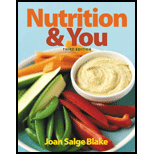
Nutrition & You (3rd Edition)
3rd Edition
ISBN: 9780321910400
Author: Joan Salge Blake
Publisher: PEARSON
expand_more
expand_more
format_list_bulleted
Concept explainers
Question
Chapter 3, Problem 8TF
Summary Introduction
To examine: Whether the statement “you absorb only 75 percent of the nutrients in your food” is true or false.
Introduction:
Expert Solution & Answer
Want to see the full answer?
Check out a sample textbook solution
Knowledge Booster
Learn more about
Need a deep-dive on the concept behind this application? Look no further. Learn more about this topic, health-nutrition and related others by exploring similar questions and additional content below.Similar questions
- Different regions of the digestive system specialize in ________ and _________ food and in __________ unabsorbed food residues.arrow_forwardExcess carbohydrates and proteins are stored as _____. a. amino acids b. starches c. fats d. monosaccharidesarrow_forwardWhich of the following statements is not true? a. Essential nutrients can be synthesized by the body. b. Vitamins are required in small quantities for bodily function. c. Some amino acids can be synthesized by the body, while others need to be obtained from diet. d. Vitamins come in two categories: fat-soluble and water-soluble.arrow_forward
- Where does the majority of fat digestion take place? a. mouth b. stomach c. small intestine d. large intestinearrow_forwardThe preferred energy sources for the body are ________.arrow_forwardThe food label in Figure 11.28 lists the nutrients and other substances in a package of ready-to-eat macaroni and cheese. Based on your reading in this chapter, how would you rate this products healthiness in terms of fats and carbohydrates? Figure 11.28 Food labels are useful health tools. Information on a food label can be used to ensure that you get the nutrients you need without exceeding recommended limits on less healthy substances such as salt, sugar, and trans fats. At present, the USDA is considering major revisions to food labels. The proposed changes include showing realistic serving sizes and sugars added by the manufacturer, and printing the calorie content per serving in larger, bolder type so that it is easier for consumers to make informed choices about purchases of prepared foods. (Left: USDA, US Department of Agriculture; Right: FoodCollection/SuperStock)arrow_forward
- Bile has a role in _________ digestion and absorption. a. carbohydrate c. protein b. fat d. amino acidarrow_forwardBy clicking on this link (http://openstaxcollege.org/l/fooddigestion) , you can watch a short video of what happens to the food you eat as it passes from your mouth to your intestine. Along the way, note how the food changes consistency and form. How does this change in consistency facilitate your gaining nutrients from food?arrow_forward
arrow_back_ios
arrow_forward_ios
Recommended textbooks for you
 Nutrition Through The Life CycleHealth & NutritionISBN:9781337919333Author:Brown, Judith E.Publisher:Cengage Learning,
Nutrition Through The Life CycleHealth & NutritionISBN:9781337919333Author:Brown, Judith E.Publisher:Cengage Learning, NutritionHealth & NutritionISBN:9781337906371Author:Sizer, Frances Sienkiewicz., WHITNEY, ElliePublisher:Cengage Learning,
NutritionHealth & NutritionISBN:9781337906371Author:Sizer, Frances Sienkiewicz., WHITNEY, ElliePublisher:Cengage Learning,





Nutrition Through The Life Cycle
Health & Nutrition
ISBN:9781337919333
Author:Brown, Judith E.
Publisher:Cengage Learning,

Nutrition
Health & Nutrition
ISBN:9781337906371
Author:Sizer, Frances Sienkiewicz., WHITNEY, Ellie
Publisher:Cengage Learning,